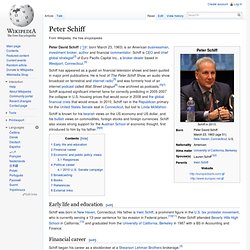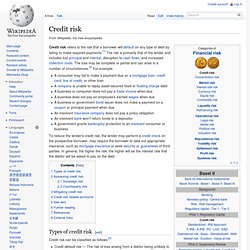

Peter Schiff. Schiff is known for his bearish views on the US economy and US dollar, and his bullish views on commodities, foreign stocks and foreign currencies.

Schiff also voices strong support for the Austrian School of economic thought, first introduced to him by his father.[8][9] Early life and education[edit] Financial career[edit] Schiff began his career as a stockbroker at a Shearson Lehman Brothers brokerage.[3] In 1996, Schiff and a partner acquired an inactive brokerage firm, renamed it Euro Pacific Capital, and began operating it from a small office in Los Angeles,[13] relocating the Firm to Darien, CT in 2005.[14] Euro Pacific Capital Inc. is currently headquartered in Westport, Connecticut, with offices in Scottsdale, Arizona, Boca Raton, Florida, Newport Beach, California, Los Angeles and New York City.[15] It specializes in non-U.S. markets and securities.
Euro Pacific Capital. Peter Schiff Show, Peter Schiff Radio Show, PART 3 of 8, First Show, 10-18-2010. Financial risk. A science has evolved around managing market and financial risk under the general title of modern portfolio theory initiated by Dr.

Credit risk. Types of credit risk[edit] Credit risk can be classified as follows:[3] Assessing credit risk[edit] Significant resources and sophisticated programs are used to analyze and manage risk.[4] Some companies run a credit risk department whose job is to assess the financial health of their customers, and extend credit (or not) accordingly.

They may use in house programs to advise on avoiding, reducing and transferring risk. They also use third party provided intelligence. Credit scoring models also form part of the framework used by banks or lending institutions to grant credit to clients. Sovereign risk[edit] Sovereign risk is the risk of a government being unwilling or unable to meet its loan obligations, or reneging on loans it guarantees. Five macroeconomic variables that affect the probability of sovereign debt rescheduling are:[9] Debt service ratioImport ratioInvestment ratioVariance of export revenueDomestic money supply growth. Portfolio (finance) Portfolio is a financial term denoting a collection of investments held by an investment company, hedge fund, financial institution or individual.[1] Risk/return plot and Pareto-optimal portfolios (in red) There are many types of portfolios including the market portfolio and the zero-investment portfolio.[4] A portfolio's asset allocation may be managed utilizing any of the following investment approaches and principles: equal weighting, capitalization-weighting, price-weighting, risk parity, the capital asset pricing model, arbitrage pricing theory, the Jensen Index, the Treynor Index, the Sharpe diagonal (or index) model, the value at risk model, modern portfolio theory and others.

There are several methods for calculating portfolio returns and performance. Jump up ^ [1] Investopedia, Portfolio definition and explanation, Retrieved July 2011Jump up ^ [2] Investopedia, Portfolio definition and explanation, Retrieved July 2011.Jump up ^ Markowitz, H.M. (March 1952). Modern portfolio theory. Modern portfolio theory (MPT) is a theory of finance that attempts to maximize portfolio expected return for a given amount of portfolio risk, or equivalently minimize risk for a given level of expected return, by carefully choosing the proportions of various assets.

Although MPT is widely used in practice in the financial industry and several of its creators won a Nobel memorial prize for the theory,[1] in recent years the basic assumptions of MPT have been widely challenged by fields such as behavioral economics. More technically, MPT models an asset's return as a normally distributed function (or more generally as an elliptically distributed random variable), defines risk as the standard deviation of return, and models a portfolio as a weighted combination of assets, so that the return of a portfolio is the weighted combination of the assets' returns.
Concept[edit] History[edit] Mathematical model[edit] This section develops the "classic" MPT model. Diversification (finance) There are many types of portfolio diversification.

Those quantifiable types may be reduced to only two; systematic diversification and idiosyncratic diversification. Idiosyncratic diversification is increased by simply holding more investments. Equally weighting the portfolio is the approach which maximizes the portfolio’s idiosyncratic diversification. Idiosyncratic diversification is typically easy to achieve. Systematic diversification is typically harder to achieve. Gravity Investments invented and patented a framework for measuring diversification in an integrated framework that equates diversification to dimensionality.
The simplest example of diversification is provided by the proverb "Don't put all your eggs in one basket". Beta (finance) The definition above covers only theoretical beta.

The term is used in many related ways in finance. For example, the betas commonly quoted in mutual fund analyses generally measure the risk of the fund arising from exposure to a benchmark for the fund, rather than from exposure to the entire market portfolio. Thus they measure the amount of risk the fund adds to a diversified portfolio of funds of the same type, rather than to a portfolio diversified among all fund types.[4] Beta decay refers to the tendency for a company with a high beta coefficient (β > 1) to have its beta coefficient decline to the market beta.
It is an example of regression toward the mean. Beta is estimated by linear regression. Where ra is the return of the asset and rb is return of the benchmark. Stock, futures and forex charting software and online trading platform. Download registration.